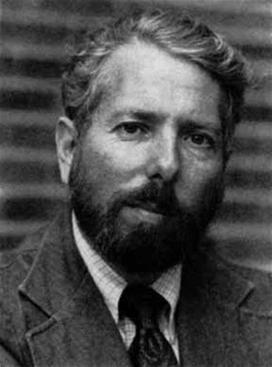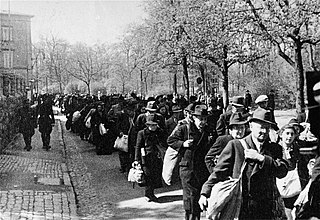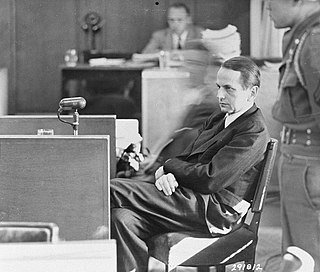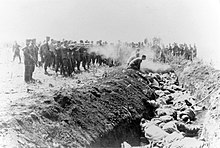
Genocide is the intentional destruction of a people in whole or in part.

Beginning on August 7, 1961, a series of social psychology experiments were conducted by Yale University psychologist Stanley Milgram, who intended to measure the willingness of study participants to obey an authority figure who instructed them to perform acts conflicting with their personal conscience. Participants were led to believe that they were assisting an unrelated experiment, in which they had to administer electric shocks to a "learner". These sham or fake electric shocks gradually increased to levels that would have been fatal had they been real.

Stanley Milgram was an American social psychologist, best known for his controversial experiments on obedience conducted in the 1960s during his professorship at Yale.
The bystander effect, or bystander apathy, is a social psychological theory that states that individuals are less likely to offer help to a victim in presence of other people. First proposed in 1964 after the murder of Kitty Genovese, much research, mostly in psychology research laboratories, has focused on increasingly varied factors, such as the number of bystanders, ambiguity, group cohesiveness, and diffusion of responsibility that reinforces mutual denial. If a single individual is asked to complete the task alone, the sense of responsibility will be strong, and there will be a positive response; however, if a group is required to complete the task together, each individual in the group will have a weak sense of responsibility, and will often shrink back in the face of difficulties or responsibilities. The theory was prompted by the murder of Kitty Genovese about which it was wrongly reported that 38 bystanders watched passively.
Diffusion of responsibility is a sociopsychological phenomenon whereby a person is less likely to take responsibility for action or inaction when other bystanders or witnesses are present. Considered a form of attribution, the individual assumes that others either are responsible for taking action or have already done so.
This is a selected bibliography and other resources for The Holocaust, including prominent primary sources, historical studies, notable survivor accounts and autobiographies, as well as other documentation and further hypotheses.
Political psychology is an interdisciplinary academic field, dedicated to understanding politics, politicians and political behavior from a psychological perspective, and psychological processes using socio-political perspectives. The relationship between politics and psychology is considered bidirectional, with psychology being used as a lens for understanding politics and politics being used as a lens for understanding psychology. As an interdisciplinary field, political psychology borrows from a wide range of disciplines, including: anthropology, economics, history, international relations, journalism, media, philosophy, political science, psychology, and sociology.
Collective responsibility is the responsibility of organizations, groups and societies. Collective responsibility in the form of collective punishment is often used as a disciplinary measure in closed institutions, e.g. boarding schools, military units, prisons, psychiatric facilities, etc. The effectiveness and severity of this measure may vary greatly, but it often breeds distrust and isolation among their members. Historically, collective punishment is a sign of authoritarian tendencies in the institution or its home society.
Kristen Renwick Monroe is an American political scientist, specializing in political psychology and ethics. Her work on altruism and moral choice is presented in a trilogy of award-winning books in which Monroe argues that our sense of self in relation to others sets and delineates the range of choice options we find available, not just morally but cognitively.
Moral disengagement is a meaning from Developmental psychology, educational psychology and social psychology for the process of convincing the self that ethical standards do not apply to oneself in a particular context. This is done by separating moral reactions from inhumane conduct and disabling the mechanism of self-condemnation. Thus, moral disengagement involves a process of cognitive re-construing or re-framing of destructive behavior as being morally acceptable without changing the behavior or the moral standards.

German collective guilt refers to the notion of a collective guilt attributed to Germany and its people for perpetrating the Holocaust and other atrocities in World War II.

A social experiment is a method of psychological or sociological research that observes people's reactions to certain situations or events. The experiment depends on a particular social approach where the main source of information is the participants' point of view and knowledge. To carry out a social experiment, specialists usually split participants into two groups — active participants and respondents. Throughout the experiment, specialists monitor participants to identify the effects and differences resulting from the experiment. A conclusion is then created based on the results. Intentional communities are generally considered social experiments.
Moral blindness, also known as ethical blindness, is defined as a person's temporary inability to see the ethical aspect of a decision they are making. It is often caused by external factors due to which an individual is unable to see the immoral aspect of their behavior in that particular situation.

Prevention of genocide is any action that works toward averting future genocides. Genocides take a lot of planning, resources, and involved parties to carry out, they do not just happen instantaneously. Scholars in the field of genocide studies have identified a set of widely agreed upon risk factors that make a country or social group more at risk of carrying out a genocide, which include a wide range of political and cultural factors that create a context in which genocide is more likely, such as political upheaval or regime change, as well as psychological phenomena that can be manipulated and taken advantage of in large groups of people, like conformity and cognitive dissonance. Genocide prevention depends heavily on the knowledge and surveillance of these risk factors, as well as the identification of early warning signs of genocide beginning to occur.

John Michael Steiner was a Czech-American Sociologist and Holocaust researcher.

The question of how much Germans knew about the Holocaust whilst it was being executed is a matter of debate by historians. With regard to Nazi Germany, some historians argue that it was an open secret amongst the population, whilst others highlight a possibility that the German population were genuinely unaware of the Final Solution. Peter Longerich argues that the Holocaust was an open secret by early 1943, but some authors place it even earlier. However, after the war, many Germans claimed that they were ignorant of the crimes perpetrated by the Nazi regime, a claim associated with the stereotypical phrase "Davon haben wir nichts gewusst".

In genocide studies, perpetrators,victims, andbystanders is an evolving typology for classifying the participants and observers of a genocide. The typology was first proposed by Raul Hilberg in the 1992 book Perpetrators Victims Bystanders: Jewish Catastrophe 1933–1945. Anthropologist Alexander Hinton credits work on this theory with sparking widespread public intolerance of mass violence, calling it a "proliferation of a post-cold war human rights regime that demanded action in response to atrocity and accountability for culprits.". The triad is also used in studying the psychology of genocide. It has become a key element of scholarship on genocide, with subsequent researchers refining the concept and applying it to new fields.

During a genocide, a rescuer or helper is someone who tries to help the genocide victims survive. In many cases, they are motivated by altruism and/or humanitarianism. The best-studied example of this phenomenon is the rescue of Jews during the Holocaust.

Genocide justification is the claim that a genocide is morally excusable/defensible, necessary, and/or sanctioned by law. Genocide justification differs from genocide denial, which is the attempt to reject the occurrence of genocide. Perpetrators often claim that genocide victims presented a serious threat, justifying their actions by stating it was legitimate self-defense of a nation or state. According to modern international criminal law, there can be no excuse for genocide. Genocide is often camouflaged as military activity against combatants, and the distinction between denial and justification is often blurred.
Prior to joining the Allied Powers late in the war, Turkey was officially neutral in World War II. Despite its neutrality, Turkey maintained strong diplomatic relations with Nazi Germany during the period of the Holocaust. During the war, Turkey denaturalized 3,000 to 5,000 Jews living abroad; between 2,200 and 2,500 Turkish Jews were deported to extermination camps such as Auschwitz and Sobibor; and several hundred interned in Nazi concentration camps. When Nazi Germany encouraged neutral countries to repatriate their Jewish citizens, Turkish diplomats received instructions to avoid repatriating Jews even if they could prove their Turkish nationality. Turkey was also the only neutral country to implement anti-Jewish laws during the war. Between 1940 and 1944, around 13,000 Jews passed through Turkey from Europe to Mandatory Palestine. According to the research of historian Rıfat Bali, more Turkish Jews suffered as a result of discriminatory policies during the war than were saved by Turkey. Since the war, Turkey and parts of the Turkish Jewish community have promoted exaggerated claims of rescuing Jews, using this myth to promote Armenian genocide denial.












